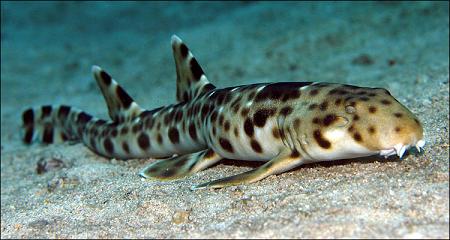Walking Sharks are One of a Kind
Walking sharks or epaulette sharks are some of the most fascinating ocean life that has been recently discovered. These sharks are found in the coastal regions of Australia, New Guinea and they have adapted to life in shallow waters of the ocean floor. These walking sharks use their pectoral fins to help them walk across the rocky crevices in the area and they have been shown to be able to handle low oxygen levels and temperatures that vary dramatically.
What some swimmers may find interesting is that while being a natural swimmer, the epaulette shark spends more time using its fins to walk along the ocean, while twisting its body back and forth, rather than swimming. That doesn’t mean that it doesn’t swim by any means. They still swim by wriggling their bodies and pushing the water with their fins and tail, to help guide and propel them through the sea.
Walking Shark’s Breath
Another unique feature of these special sharks is that they are able to breath differently from the traditional ramming motion that their larger counterparts rely on. That means they do not need to swim to breathe. Unlike human breathing in swimming, they have muscles in their neck that helps to pump water over their gills, which allows them to breathe easier.
Shape and Skin and Color
This shark is unique in that is has an almost eel-like shape to it. The skin varies between brown to a creamy color on these unique forms of ocean life. Its nose is rounded and on the underside are nasal barbells. They also have a paddle shaped pectoral fin and prominent eyes on their head. For tearing apart his prey, the fish has 26 – 35 upper row teeth and 21 – 32 teeth on the lower jaw. These teeth are small, sharp and have broad bases. On average, their body reaches only 27” – 35”, with some epaulette sharks being reported to reach 42”. Their average lifespan is 20 – 25 years.
The picture above comes from the BBC. Another nice picture can be found on marine life blog.
Walking Shark Nutrition
As a nocturnal creature, they are more active at night. Unlike human nutrition, their main diet consists of crabs, shrimp, small fish, and of course, worms. When they feed on prey, it tends to be small enough that the prey can be quickly consumed by the tiny razor sharp teeth that line the shark’s mouth. Although, a majority of the prey the walking shark consumes is swallowed whole when possible in the wild.
While they will get relatively close to humans, since they are found in shallow waters, they tend to swim away quickly, rather than to interact in general. Those visiting the waters that contain these fish will find that they remain some of the most interesting specimens alive. Those fortunate enough to swim in the same ocean waters as them tend to agree, they are among the most fascinating creatures alive.
Today’s Daily Swimming Workout
Warm-up: 500 relaxed and buoyant 100 breaststroke kick, 300 Individual Medley, 100 butterfly-on-back kick
200 backstroke, 200 freestyle
4 X 100 drill first 25, Individual Medley order
5 X 100 odd 100’s butterfly, evens freestyle
5 X 100 odd 100’s backstroke, evens freestyle
5 X 100 odd 100s breaststroke, evens freestyle
5 X 100 as 25 slide and glide freestyle drill, 75 freestyle
Kick with swim fins on: 10 X 50 your choice of stroke streamlined
Warm-down: 200 superslow, tai-chi style swimming
Total: 4500 meters or yards
back to the top of walking sharks page









